Executive Summary:
- Fesler’s design team uses a Millermatic 251 and Millermatic 252 to perform hundreds of tack welds on body panels and custom parts. Both units provide great arc starts and low spatter.
- The controls on the Dynasty 350 give precise control over the arc cone width – a useful feature for welding into tight joints.
The Death of Rust Bucket Hot Rods
In the hot-rod world, the worst thing you can have on a car is a ton of body filler. On older cars, it's common to find some, but if your ride is caked in it, you may be at risk for undersurface rust and potential paint flaws.
Modern hot rod fabrication requires a sharp attention to detail with flawless metalwork, and no one knows this better than Chris Fesler, owner of Arizona-based Fesler Built. The old way of restoring rods using a filler patch is no longer acceptable by fabricators who know how to weld and do the job right.
The unique cars that Felser Built is known for are all handcrafted from raw steel, a process that takes time, talent and the right equipment. Fesler's team of fabricators rely on the speed of a 250-amp Millermatic® MIG welder and the control of their 350-amp Dynasty® 350 AC/DC TIG welder to repair and customize some of the hottest classic cars on the road.
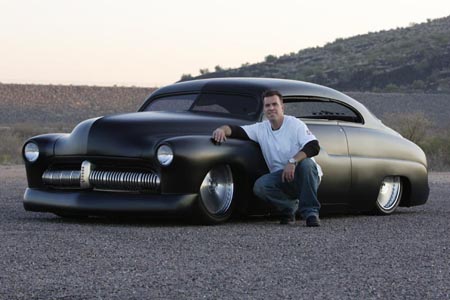
"Everything we create is hand-built out of metal. There is no fiberglass; this is real-deal hot rod restoration," says Fesler. "Every car we work on is stripped down to raw metal and coated with a primer for protection while we weld and fabricate."
Off with the Old, On with the New
Many classic designs from major automotive manufacturers were fabricated from pot metal, a faster, cheaper way to build car parts for mass production. The obvious benefit is that original equipment manufactured, (OEM) parts are quickly reproduced, however lack the strength and longevity of pure carbon steel.
Fesler Built builds high-end custom and concept cars that are driver friendly for the serious car enthusiast who just wants to show off. The shop is respected for fabricating or replacing OEM body panels with custom components handcrafted from pure steel. Fesler's design team is skilled in a variety of metalworking equipment from welders and English wheels to the simple sandbag and rubber hammer.
When it comes time to weld, the design team uses a Millermatic® 251 and Millermatic® 252 to perform hundreds of tack welds on body panels and custom parts. Both units provide great arc starts and low spatter, which saves the team hours of grinding time.
To Fesler, the way a car appears is just as important as the way it is built. While the MIG welding process offers fabricators speed, a TIG welder offers the appearance of a smoother bead without the spatter. The controls on the Dynasty 350 give precise control over the arc cone width-a useful feature for welding into tight joints.
Modern welding equipment can make the metalwork easier for fabricators by offering increased speed and control, while an all-metal repair can give the classic car owner the lasting satisfaction of a job done right.
One Pretty Pony
A '66 Ford Mustang rolled into Fesler's shop for a new paint job and suspension upgrade. A look under the original paint revealed body filler and rust on the quarter panels and floors. The customer requested that Fesler repair the panels, along with a few other modifications, turning the matching-numbered Mustang into a pro-touring vehicle with a radical style.
"Looking at a paint job, undercarriage and interior over the internet is not the way to buy a car," adds Fesler. "There is no way to tell what is underneath that paint. It can look good from five feet away, but when you get up to it and notice rust bubbles or panel problems, you'll be stripping that car, which can set you back financially." The message is simple: trade your body filler for a welder and get the job done right.
Fesler will fabricate several parts to prepare the Mustang for an appearance at the 2007 SEMA show. Externally, a custom grill, hood scoop, headlight buckets, shortened and tucked muffler, new one-piece lower valence, fenders, drip-rail, shaved doors and a stretched rear-end fin, gas tank cover and flushed billet lights top Fesler's list of to-do's. Most of the time, Fesler replaces multi-component assemblies with newly handcrafted one-piece components. This extra step eliminates the manufacturing shortcuts while improving the strength of the part. "It's a custom design, yet we try to keep everything built on the car streamlined with that factory look," says Fesler.
The incorrect fitting of a custom component can be a common problem discovered after painting, when the car needs to go back together and doesn't. To get around this, Fesler maintains a 1/16-in. body seam all the way around the car by welding tabs to the attached components, keeping everything symmetrical thru the build process. When finished, the tabs are removed, revealing a perfect fit.
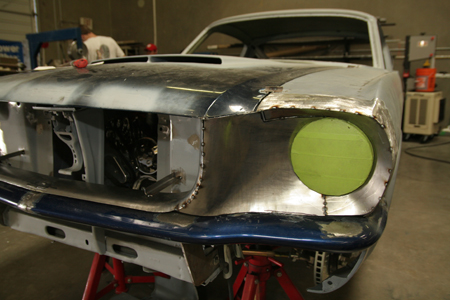
The left headlight bucket of the '66 Mustang, seen here, was fabricated by hand to get the curve and smooth lines that Fesler was going for. "The fun part with car exteriors is trying to duplicate a custom piece to perfectly match the other side," says Fesler
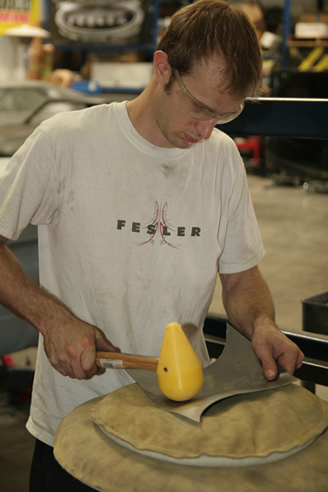 .
.
Pure strength is required to shape this piece of metal into the matching right front headlight bucket. Fesler technician Jeff Hawthorn uses a sandbag, rubber hammer and plenty of determination to give the metal a rough shape.
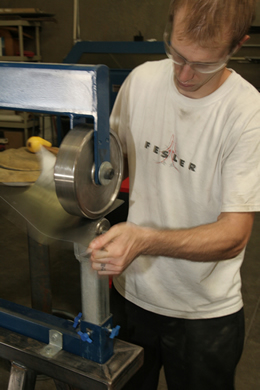
To smooth out the form, the metal is vigorously run through an English wheel. Slight variations can be made to the shape by alternating pressure and angle; this skill comes with plenty of practice, and it also helps to have an eye for sculpting and shaping.

Hawthorn uses a pair of tin snips to cut small release points along the leading edge of the headlight bucket. Next, a device called a shrinker is used to pull the metal edge into a nicely beveled, circular shape.
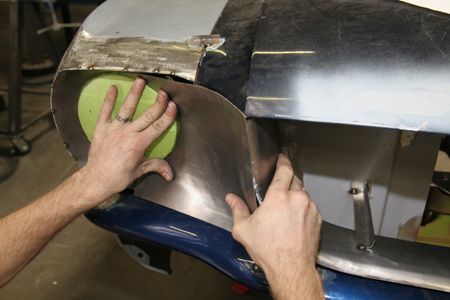
Once the final fit-up looks right, the piece is tacked welded to prevent movement. "We usually try to weld slow and use a little thicker material than what the stock metal was to minimize warping," comments Hawthorn. The end product is a pair of perfectly symmetrical, matching headlight buckets.
Basic Metalworking for Your Rod
Fesler technician Jeff Hawthorn recommends the following metalworking tools to get you up and running before your car does:
Basics:
Shears
Brake press
Simple tin snips
Basic body hammers
MIG Welder
Lots of practice
More Advanced:
Sandbag and mallets
English wheel
Instructional videos and books
TIG Welder
Plasma Cutter
Even more practice
Style that'll Knock your Lights Out
Across Fesler's shop, another stock vehicle is undergoing a custom transformation. A '67 Chevy C-10 Blazer is getting an upgrade with the installation of flush-fit LED billet tailights-something that is not a stock item from '67.
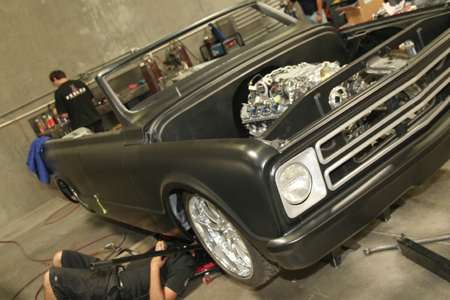
The Blazer has a hint of pro touring, and hot rod style with custom body panels that were designed to reflect a stock feel. This car commands attention as possibly the most advanced '67 ever built, and a quick look under the hood reveals why.
A lot of custom components were added, such as a super-charged cLS1 engine, pulley system, intake, fenders, radiator, frame, stock rails, racing suspension, dash, gear cluster and stereo system. Fesler technician Chris Cowen gets down to work on installing the LED taillights.
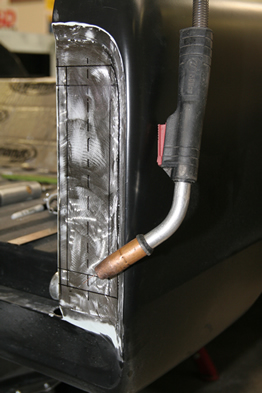
After the old stock taillights were removed, this plate was welded in as the new face that the tail lights will fit into. Cowen used a grinder to ensure a flat surface. The LED light mount was lined up and outlined on the metal.
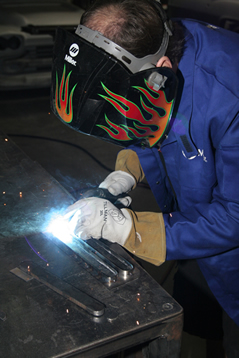
Cowen uses the Millermatic to MIG weld a custom light chassis together. This chassis will allow the lights to be flush mounted to the faceplate on the tail of the '67 Chevy.
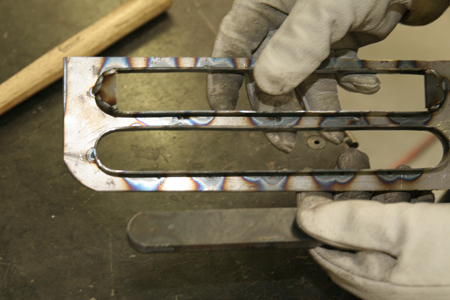
When welding custom parts that require curves, Cowen recommends using a metal template such as the one seen below to obtain a tight, accurate fit-up while welding. This technique also saves on rework caused by free hand welding. On 18-gauge steel, it's best to use short, quick tacks to first get the parts lined up right.
The exceptional arc starts of the Millermatic makes it a very natural tool for fabricators doing numerous, repetitive tacks on thin body panels or headlight buckets.
Cowen adds, "If a part is not working out, scrap it and start over to get the desired quality. Don't compromise just to finish; it's not worth it."
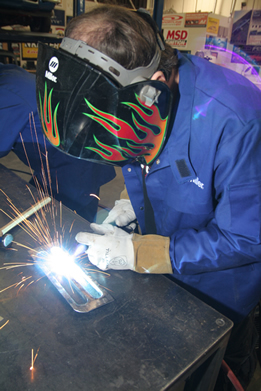
Next, the final finish welds are completed. Pay close attention to your heat input so that you don't warp the thin metal.

A final test of the light kit shows a perfect fit.
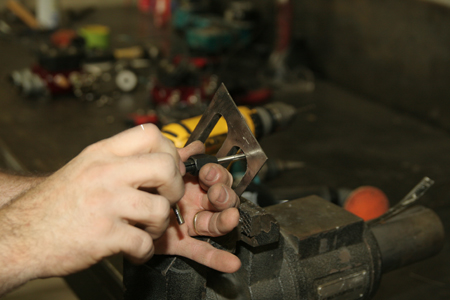
The chassis is put into a vice and four holes are tapped for the light housing's counter-sunk allen bolts.
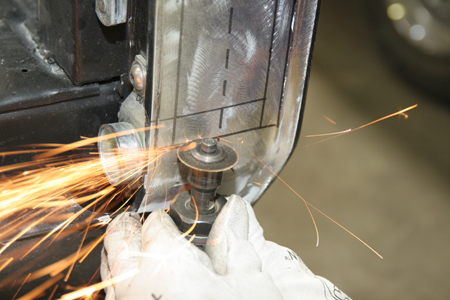
The outline on the faceplate provides a straight guide as it's removed using this cut off wheel. The dimensions are exactly the same as the new light chassis that will slip into place.
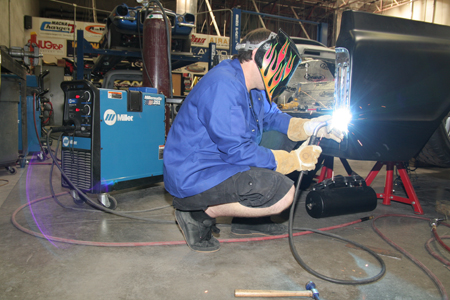
With the new light chassis fitting into the faceplate, Cowen uses the Millermatic to tack it into place.
Cowen recommends taking a moment to check the fit, making sure that nothing moved during welding.
One final check with the light housing shows that everything is tight and flush. The finished welds are all that are left to complete the project. Metalworking is tedious and time consuming, but the benefits are long lasting as the car.
"TV is not reality," states Fesler. "It takes on average, a year or two to build most custom vehicles. I recommend to everyone looking to get anywhere in this industry to get out to as many car shows as you can, read magazines, ask questions of the builders and then apply what you've learned. Seek out books and Web sites like MillerWelds.com for advice that won't set you back."
Feature cars come and go through the Fesler shop at a rapid pace. A little change is sometimes all a classic needs to give it a sense of individuality. Anytime the Fesler Built team picks up the welding torch to customize and fabricate, they know they are installing the highest-level of quality that their customers have come to expect, literally building themselves a name in the industry.